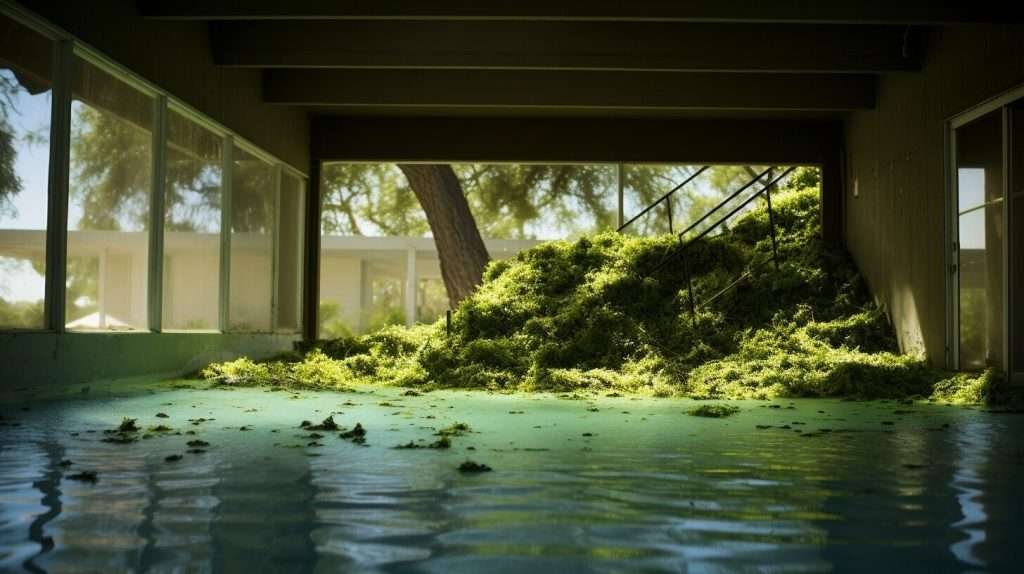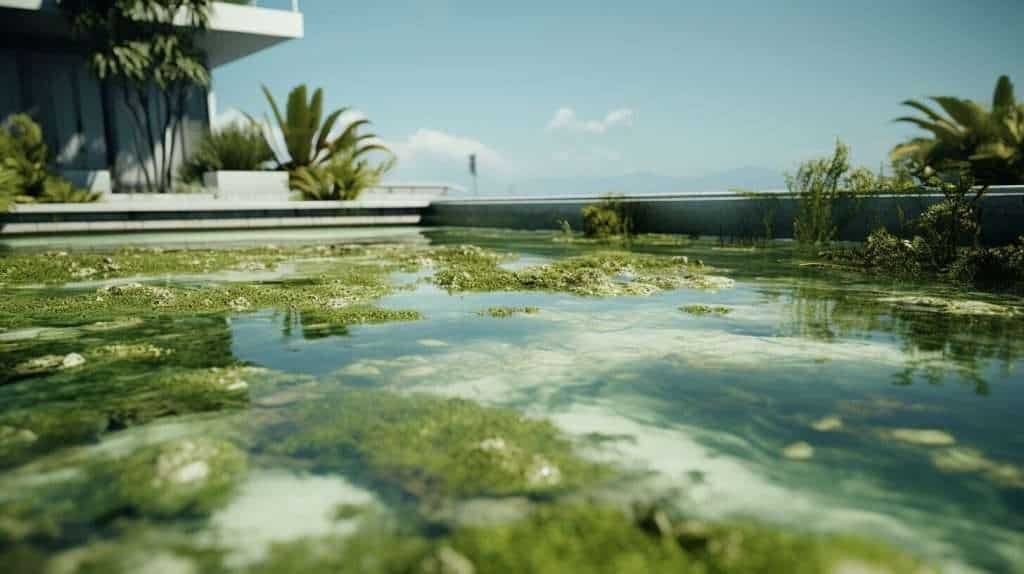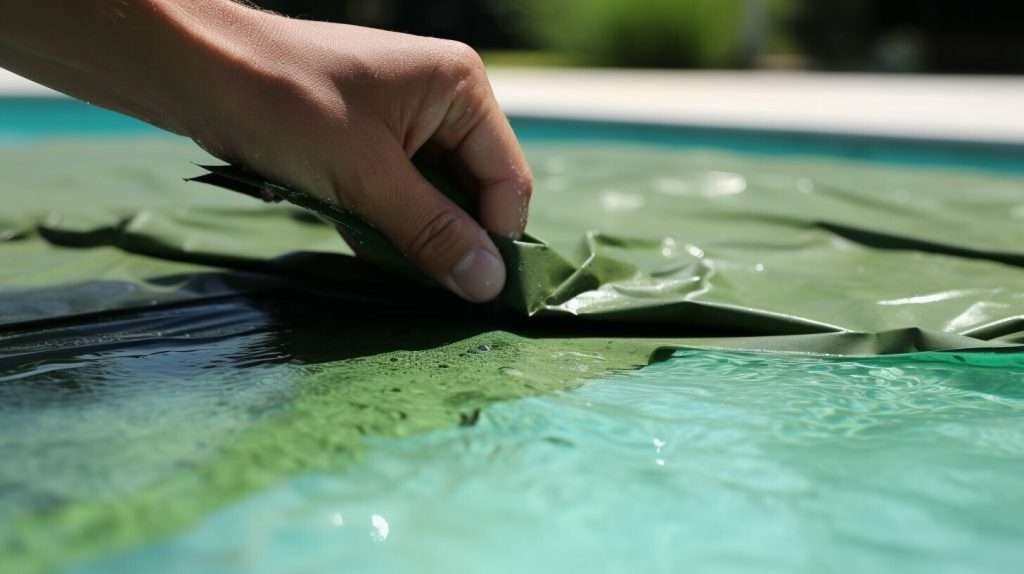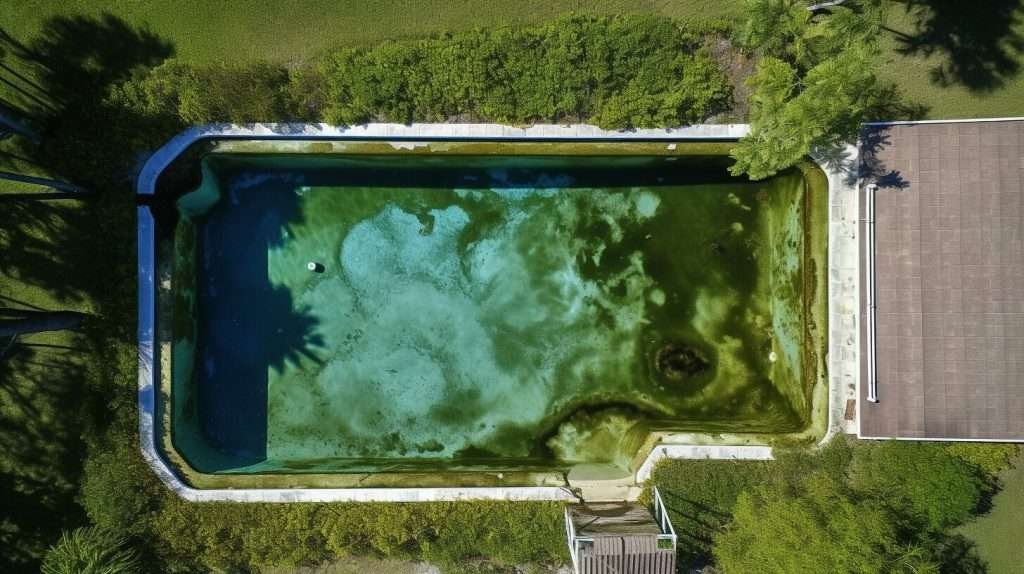Welcome to my latest article where I will be exploring the topic of whether or not pool covers can cause algae growth. This is a common concern among pool owners, but there are many myths surrounding this issue. In this article, I will be debunking these myths and providing you with tips for maintaining a clean and algae-free pool. So let’s dive in! One of the most common misconceptions about pool covers is that they can cause algae growth by trapping in heat and creating the perfect environment for algae to thrive. However, with proper maintenance and cleaning, pool covers can actually help prevent algae growth by keeping debris out of the water. To ensure a clean and algae-free pool, be sure to regularly remove any debris from the cover, clean and maintain the cover itself, and follow safe water opening tips when uncovering the pool for the season.
Key Takeaways
- Pool covers do not directly cause algae growth, but improper usage can contribute to its development.
- Factors such as sunlight exposure, lack of circulation, and the presence of nutrients all contribute to algae formation in pools.
- Proper maintenance and usage of pool covers is crucial for preventing algae growth and maintaining good water quality in pools.
Understanding Algae Formation in Pools
Algae growth is a common problem for pool owners, and can be caused by a variety of factors. Understanding these factors can help prevent and manage the growth of algae in your pool.
Sunlight exposure is one of the main contributors to algae growth. Algae thrive on sunlight, and without adequate shading or filtration, can quickly grow out of control. Lack of circulation is also a major factor, as standing water provides an ideal environment for algae to flourish. Finally, the presence of nutrients such as phosphates and nitrates in the pool can provide a food source for algae.
Pool covers can potentially affect each of these factors, and as such can impact the growth of algae in your pool. When a pool cover is used, it limits the amount of sunlight that reaches the water, reducing the potential for algae growth. Additionally, it can prevent debris from entering the pool, limiting the presence of nutrients. However, if a pool cover is not properly maintained or fitted, it can contribute to poor water circulation, which in turn provides an ideal environment for algae growth.
Overall, understanding the factors that contribute to algae growth in pools can help inform the proper use and maintenance of pool covers to prevent algae growth.

Dispelling the Myth: Pool Covers as Algae Catalysts
Let me clarify an important point: pool covers alone do not cause algae growth. While it’s true that pool covers can contribute to the development of algae, they do not introduce algae into the pool. It’s a common misconception that pool covers are the cause of all algae problems, but this is simply not the case.
Here’s why: algae require certain conditions to grow, such as sunlight exposure, availability of nutrients, and lack of water circulation. Pool covers can impact these factors and influence algae growth. For example, a pool cover that is not properly fitted or placed can limit sunlight exposure and lead to imbalances in chemical levels. A pool cover that is not cleaned regularly can trap organic debris and contribute to poor water circulation. These factors can all contribute to the development of algae.
However, it’s important to note that if a pool cover is used correctly and maintained properly, it can actually help inhibit algae growth. For example, a well-fitting and properly placed pool cover can limit sunlight exposure and reduce the availability of nutrients, which can help prevent algae growth. Additionally, using a pool cover can prevent debris from entering the pool, which can also contribute to the prevention of algae growth.
So, while pool covers can indeed play a role in algae growth, they should not be demonized as the sole cause of algae problems. Proper maintenance and usage of pool covers is key to preventing algae growth and maintaining a clean and healthy pool.
How Pool Covers Can Impact Water Quality
As discussed in the previous section, pool covers can play a role in algae growth if not used correctly. Poor water circulation, increased organic debris, and imbalances in chemical levels can all contribute to the development of algae in a pool. But why does this happen?
When a pool cover is not cleaned regularly, it can trap debris such as leaves, twigs, and insects. This debris can break down and release nutrients into the water, creating a food source for algae. In addition, poor water circulation can prevent the distribution of chemicals and limit the effectiveness of filtration systems, allowing algae spores to thrive.
Image source: 
It’s important to note that not all pool covers are created equal. Some covers are designed specifically to promote water circulation and prevent debris buildup, while others may hinder proper filtration and chemical distribution. When choosing a pool cover, it’s important to consider its compatibility with your filtration system and maintenance routine.
To prevent algae growth and maintain water quality, it’s crucial to clean your pool cover regularly and ensure proper fit and placement. This will promote healthy circulation and prevent debris buildup, reducing the risk of algae formation. Additionally, maintaining proper chemical balance and monitoring filtration efficiency can help prevent the growth of algae and other harmful organisms.
Maintaining Pool Covers to Prevent Algae Growth
Proper maintenance of pool covers is crucial to prevent the growth of algae. Here are some tips for maintaining your pool cover:
- Regularly clean your pool cover with a mild detergent and a soft brush to remove any debris or dirt.
- Remove any excess water or debris on the cover before folding and storing it.
- Ensure that the cover properly fits the pool and is not sagging or tearing.
- Keep the pool cover dry when not in use to prevent the growth of mold or mildew.
Additionally, it is important to routinely check the condition of your pool cover and replace it if it shows signs of wear and tear. A damaged cover can allow debris and sunlight to penetrate the pool, contributing to algae growth.
By following these maintenance tips, you can help ensure that your pool cover is functioning properly and effectively preventing algae growth.

Algae Control and Pool Covers
Proper use of pool covers can be an effective tool for controlling algae growth in your pool. When used correctly, pool covers can limit sunlight exposure, reduce the availability of nutrients, and prevent debris from entering the pool, all of which can help inhibit algae growth.
Tip: If you live in an area with particularly hot and sunny weather, consider choosing a pool cover with high UV resistance to further limit sun exposure.
However, it’s important to note that pool covers alone cannot completely prevent algae growth. Regular maintenance and proper usage are still necessary to maintain a healthy pool environment. A dirty or ill-fitting cover can actually contribute to algae growth by causing poor water circulation and debris buildup.

Tip: Always remove your pool cover regularly to allow for adequate circulation and sunlight exposure. Be sure to clean and properly store your cover when not in use to prevent debris buildup and maintain its effectiveness.
It’s also important to maintain proper water chemistry and regularly monitor filtration efficiency. A pool cover should be part of a comprehensive algae prevention plan, rather than the sole solution.
Tip: Use a pool cover in conjunction with regular brushing and vacuuming to further prevent debris buildup and ensure a clean pool.
Overall, proper use of a pool cover can be an effective tool for controlling algae growth in your pool. However, it should be used in conjunction with proper maintenance routines and a comprehensive algae prevention plan for best results.
Algae Prevention Strategies with Pool Covers
Along with proper maintenance, using pool covers can be an effective tool for preventing algae growth. Here are some strategies to keep in mind:
- Chemical treatments: Use appropriate chemical treatments, such as algaecides, to help inhibit algae growth. Be sure to follow instructions carefully and avoid overuse, which can lead to imbalances and other water quality issues.
- Water balance: Maintain proper water balance, including pH and alkalinity levels. Algae thrive in unbalanced water, so regular testing and adjustments are crucial.
- Filtration: Ensure proper filtration efficiency by cleaning filters regularly and monitoring pressure. A poorly functioning filtration system can allow algae to thrive.
- Limit debris: Use pool covers to prevent debris from entering the pool, which can introduce nutrients and encourage algae growth.
- Proper usage: Use pool covers consistently and correctly, removing them regularly to allow for sunlight exposure and ensuring a proper fit. Improper usage can contribute to poor water circulation and other factors that can lead to algae growth.

Remember, pool covers are just one component of a comprehensive algae prevention plan. By combining best practices and strategies, you can keep your pool clean, healthy, and algae-free year-round.
How Pool Covers Contribute to Algae Growth
Although pool covers are often viewed as a helpful tool for preventing algae growth, they can also inadvertently contribute to the problem if not used or maintained properly.
One key factor that can impact algae formation is water circulation. If the cover is not removed frequently enough or is not properly fitted, it can restrict water flow and create stagnant areas where algae can thrive.
Another way in which pool covers can contribute to algae growth is by limiting UV exposure. UV rays can inhibit algae growth, so if covers are not removed regularly, or if they are opaque, they can prevent sunlight from reaching the pool water and allow algae to flourish.
Finally, improper use or maintenance of pool covers can lead to imbalances in chemical levels. If covers are not cleaned regularly, for example, they can accumulate organic debris and bacteria that can throw off chemical levels and create an environment conducive to algae.
It’s important to note, however, that these issues can usually be avoided with proper maintenance and usage of pool covers. Regular cleaning, ensuring proper fit and placement, and removing covers regularly for sunlight exposure can all help prevent these problems and keep your pool clean and algae-free.

Addressing Green Pool Water Issues
Green pool water is a common issue that can be caused by a variety of factors, including algae growth. However, with proper maintenance and usage of pool covers, you can prevent this problem from occurring. Here are some tips for addressing green pool water issues:
- Check chemical levels: One of the most common causes of green pool water is imbalanced chemical levels. Test the water regularly and adjust the levels as needed to ensure proper sanitation and clarity.
- Monitor filtration: A well-functioning pool filter is essential for preventing algae growth. Be sure to clean the filter regularly and check for any signs of damage or wear.
- Remove debris: Debris such as leaves and twigs can contribute to algae growth. Be sure to skim the surface of the pool regularly and remove any debris that has accumulated on the pool cover.
- Use chemical treatments: If algae growth has already begun, chemical treatments can help address the problem. Follow the instructions carefully and use the appropriate products for your pool type and size.
| Image: | 
|
|---|
Remember, prevention is key when it comes to green pool water and algae growth. By using a pool cover properly and maintaining your pool regularly, you can enjoy a clean and healthy pool all season long.
Best Practices for Using Pool Covers
Proper usage and maintenance of pool covers are critical for preventing algae growth and maintaining a clean and healthy pool. Here are some best practices to keep in mind:
- Use a properly fitting cover that completely covers the pool surface, without gaps or wrinkles that could allow debris to enter.
- Remove the cover regularly, especially during daylight hours, to allow sunlight exposure that can help limit algae growth.
- Use appropriate chemicals, and maintain proper water balance, to ensure that the pool water is not providing excess nutrients that can feed algae.
- Regularly clean and maintain the cover, removing debris and ensuring proper fit and placement. A dirty or damaged cover can affect water quality and lead to algae growth.
- Monitor filtration efficiency, ensuring that the system is working properly and that the water is being effectively circulated and filtered.
By following these best practices, you can maximize the effectiveness of your pool cover in preventing algae growth. Remember that a pool cover is just one tool in a comprehensive approach to algae prevention, and regular maintenance and monitoring are critical for a clean and clear pool.

Conclusion
After exploring the relationship between pool covers and algae growth, it is clear that pool covers alone do not cause algae in pools. However, they can contribute to its development under certain conditions. Therefore, it is crucial to follow proper maintenance and usage of pool covers to prevent algae growth.
Factors such as sunlight exposure, water circulation, and chemical balance all play a role in algae formation in pools. If pool covers are not used correctly, they can exacerbate these factors and lead to poor water quality and increased organic debris. Additionally, inadequate distribution of chemicals and lack of UV exposure can inadvertently contribute to algae growth.
By following best practices for using pool covers, such as ensuring proper fit and placement, removing the cover regularly for sunlight exposure, and monitoring chemical balance, pool owners can reduce the likelihood of algae growth and maintain a clean and healthy pool. It is also important to incorporate pool covers into a comprehensive algae prevention plan, which may include chemical treatments, regular maintenance, and appropriate filtration.
Remember to Stay Diligent
As a professional copywriting journalist, I recommend that pool owners remain diligent in their efforts to prevent algae growth and maintain a clean and healthy pool. By staying informed on the best practices for pool cover usage and regular maintenance routines, pool owners can enjoy their pools while minimizing the risk of algae formation and other water-related issues.
Can Using a Pool Cover Pump Help Prevent Algae Growth in the Pool?
Using a pool cover pump is one of the top pool cover pump recommendations to prevent algae growth in the pool. By efficiently removing excess water from your pool cover, it helps eliminate potential breeding grounds for algae. This proactive approach greatly reduces the risk of an algae-infested pool, ensuring clean and crystal-clear water for your swimming enjoyment.
Do Automatic Pool Covers Prevent Algae Growth?
Automatic pool covers are highly effective in preventing algae growth. These covers act as a barrier, preventing sunlight and debris from entering the pool, which are two crucial factors for algae growth. By keeping the pool covered, automatic pool covers help maintain water clarity, reduce the need for excessive chemical treatments, and ultimately contribute to a cleaner and healthier swimming environment.
FAQ
Q: Can pool covers cause algae?
A: Pool covers alone do not cause algae to form in the pool. However, if not used correctly or maintained properly, pool covers can contribute to the growth of algae.
Q: How do pool covers impact water quality?
A: Improper usage or lack of maintenance of pool covers can lead to poor water circulation, increased organic debris, and imbalances in chemical levels, all of which can contribute to algae growth.
Q: Can pool covers be used to prevent algae growth?
A: When used correctly, pool covers can be a useful tool for algae control. They can limit sunlight exposure, reduce the availability of nutrients, and prevent debris from entering the pool, all of which inhibit algae growth.
Q: What are some tips for maintaining pool covers to prevent algae?
A: Regular cleaning, removing debris, and ensuring proper fit and placement of the cover are essential for preventing algae growth. It is important to establish a regular maintenance routine for pool covers.
Q: What are some additional strategies for preventing algae growth using pool covers?
A: In addition to maintaining pool covers, using chemical treatments, maintaining proper water balance, and monitoring filtration efficiency are important steps in preventing algae growth. Pool covers should be part of a comprehensive algae prevention plan.
Q: How can pool covers contribute to algae growth?
A: Improper usage of pool covers can lead to poor water circulation, lack of UV exposure, and inadequate chemical distribution, all of which can inadvertently contribute to algae growth.
Q: How can pool covers help prevent green pool water?
A: Pool covers, when used correctly along with regular maintenance, proper filtration, and appropriate chemical use, can help prevent green pool water by inhibiting the growth of algae.
Q: What are some best practices for using pool covers?
A: Using a properly fitting cover, removing the cover regularly for sunlight exposure, and ensuring proper chemical balance are some best practices for using pool covers to maintain a clean and algae-free pool.


